
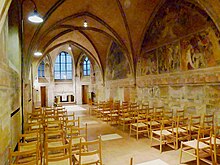
St. Anne's Church (German : St. Anna-Kirche) in Augsburg, Germany, is a medieval church building that was originally part of a monastery built in 1321. It is notable for its elaborate interior decoration.


St. Anne's Church (German : St. Anna-Kirche) in Augsburg, Germany, is a medieval church building that was originally part of a monastery built in 1321. It is notable for its elaborate interior decoration.
St. Anne's was built in 1321 by Carmelite friars. In 1518 Martin Luther stayed there with the Carmelite friars when he was in Augsburg to meet the papal legate, Cardinal Cajetan, who wanted Luther to submit to the pope. The church converted to Lutheranism in 1545.
On October 31, 1999, representatives of the Catholic and Evangelical Lutheran churches signed the Joint Declaration on the Doctrine of Justification in the Church of St. Anna. This is considered one of the most important events for the ecumenical movement. After a long period of closure, the Lutherstiege museum was reopened in 2012. A comprehensive renovation was completed in 2016/17.
The Goldsmiths' Chapel (Goldschmiedekapelle) was donated in 1420 by Conrad and Afra Hirn.
Together with his brother Ulrich Fugger the Elder and on behalf of his deceased brother Georg Fugger, Jakob Fugger founded the Fugger chapel in the choir of the church in front of the high altar. It became the burial place of the three brothers and their two nephews Raymund Fugger and Hieronymus Fugger (1499–1538). The Fugger chapel is the earliest example of Renaissance architecture in Germany. Among the features are a marble pavement, an organ with painted shutters, stained glass, choir stalls, a sculptural group of the Lamentation of Christ, and memorial relief tablets in the style of Dürer. The spire was added in 1607 by Elias Holl. The church ceiling is decorated with Baroque and Rococo stuccowork, with frescoes by Johann Georg Bergmüller.
In 1518 the chapel was consecrated to the patron saint of Jesus Christ in the altar sacrament, the Holy Virgin Mary and the Evangelist Matthew and has remained a consecrated Catholic place of worship to this day. When St. Anne's Church became Protestant in 1548, the Fugger Chapel remained Catholic because the Fugger Foundation continued to look after it and contributed to the upkeep of the church. This is how the remarkable fact came about that part of the church is denominationally different from the rest, and that the burial place of the Fugger family, who are considered strictly Catholic, is now in a Protestant church. [1] Adding to the oddity is that Jacob Fugger's loans to Cardinal Albert of Brandenburg and the indulgence to repay them were what triggered Martin Luther's Reformation.
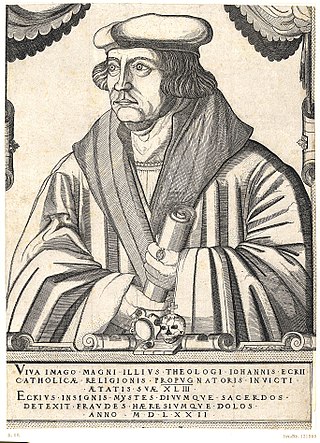
Johann Maier von Eck, often anglicized as John Eck, was a German Catholic theologian, scholastic, prelate, and a pioneer of the counter-reformation who was among Martin Luther's most important interlocutors and theological opponents.

The House of Fugger is a German family that was historically a prominent group of European bankers, members of the fifteenth- and sixteenth-century mercantile patriciate of Augsburg, international mercantile bankers, and venture capitalists. Alongside the Welser family, the Fugger family controlled much of the European economy in the sixteenth century and accumulated enormous wealth. The Fuggers held a near monopoly on the European copper market.

The Book of Concord (1580) or Concordia is the historic doctrinal standard of the Lutheran Church, consisting of ten credal documents recognized as authoritative in Lutheranism since the 16th century. They are also known as the symbolical books of the Evangelical Lutheran Church.

The diets of Augsburg were the meetings of the Imperial Diet of the Holy Roman Empire held in the German city of Augsburg. Both an Imperial City and the residence of the Augsburg prince-bishops, the town had hosted the Estates in many such sessions since the 10th century. In 1282, the diet of Augsburg assigned the control of Austria to the House of Habsburg. In the 16th century, twelve of thirty-five imperial diets were held in Augsburg, a result of the close financial relationship between the Augsburg-based banking families such as the Fugger and the reigning Habsburg emperors, particularly Maximilian I and his grandson Charles V. Nevertheless, the meetings of 1518, 1530, 1547/48 and 1555, during the Reformation and the ensuing religious war between the Catholic emperor and the Protestant Schmalkaldic League, are especially noteworthy. With the Peace of Augsburg, the cuius regio, eius religio principle let each prince decide the religion of his subjects and inhabitants who could not conform could leave.

Johann (Johannes) Brenz was a German Lutheran theologian and the Protestant Reformer of the Duchy of Württemberg.
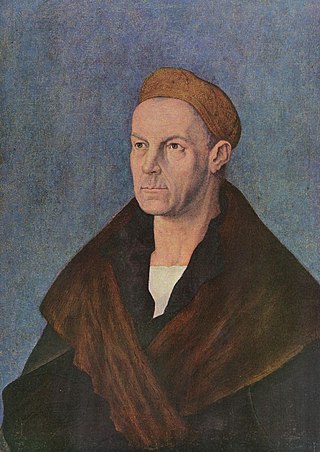
Jakob Fuggerof the Lily, also known as Jakob Fuggerthe Rich or sometimes Jakob II, was a major German merchant, mining entrepreneur, and banker. He was a descendant of the Fugger merchant family located in the Mixed Imperial City of Augsburg, he was born and later also elevated through marriage to Grand Burgher of Augsburg. Within a few decades, he expanded the family firm to a business operating in all of Europe. He began his education at the age of 14 in Venice, which also remained his main residence until 1487. At the same time, he was a cleric and held several prebendaries, even though he lived in a monastery, Jakob found time to study the history of investment in early Asian markets. American journalist Greg Steinmetz has estimated his overall wealth to be around $400 billion in today’s money, equivalent to 2% of the GDP of Europe at that time.

Henry IV the Pious, Duke of Saxony was a Duke of Saxony from the House of Wettin. Succeeding his brother George, Duke of Saxony, a fervent Catholic who sought to extinguish Lutheranism by any means possible, Henry established the Lutheran church as the state religion in his domains.

Charles II, Margrave of Baden-Durlach, nicknamed Charles with the bag, governed the Margravate of Baden-Durlach from 1552 to 1577. On 1 June 1556 Charles issued a new Church Order, which made Lutheranism the official religion in Baden-Durlach.
Lutheranism as a religious movement originated in the early 16th century Holy Roman Empire as an attempt to reform the Roman Catholic Church. The movement originated with the call for a public debate regarding several issues within the Catholic Church by Martin Luther, then a professor of Bible at the young University of Wittenberg. Lutheranism soon became a wider religious and political movement within the Holy Roman Empire owing to support from key electors and the widespread adoption of the printing press. This movement soon spread throughout northern Europe and became the driving force behind the wider Protestant Reformation. Today, Lutheranism has spread from Europe to all six populated continents.
The Philippists formed a party in early Lutheranism. Their opponents were called Gnesio-Lutherans.

Kirchheim or Kirchheim in Schwaben is a municipality and a market town in the district of Unterallgäu in the region of Swabia (Schwaben) in the south-west of Bavaria, Germany. The town was greatly influenced by the Fugger family. North-east of the town lies the Augsburg Western Woods Nature Park.

Luther is a 2003 historical drama film dramatizing the life of Protestant Christian reformer Martin Luther. It is directed by Eric Till and stars Joseph Fiennes in the title role. Alfred Molina, Jonathan Firth, Claire Cox, Bruno Ganz, and Sir Peter Ustinov co-star. The film covers Luther's life from his becoming a monk in 1505, to his trial before the Diet of Augsburg in 1530. The American-German co-production was partially funded by Thrivent Financial for Lutherans, a Christian financial services company.

The Prince-Bishopric of Augsburg was one of the prince-bishoprics of the Holy Roman Empire, and belonged to the Swabian Circle. It should not be confused with the larger diocese of Augsburg, over which the prince-bishop exercised only spiritual authority.

Konrad Wimpina was a German Roman Catholic theologian and humanist of the early Reformation period. He was a quiet and stubborn conservative, considered quiet but somewhat narrow. In theology he was a pupil of Martin Polich of Mellerstadt and a Thomist.
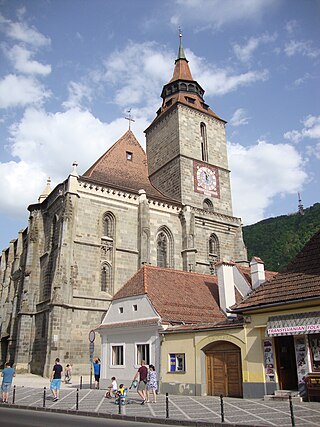
The Evangelical Church of the Augsburg Confession in Romania is a German-speaking Lutheran church in Romania, mainly based in Transylvania. As a Lutheran church, it adheres to the Augsburg Confession. Its history goes back to the 12th century when the Transylvanian Saxons arrived in the region, then part of the Kingdom of Hungary.

Johann, known as Johann the Steadfast or Johann the Constant, was Elector of Saxony from 1525 until 1532 from the House of Wettin.

Paul Speratus was a Swabian Catholic priest who became a Protestant preacher, reformer and hymn-writer. In 1523, he helped Martin Luther to create the First Lutheran hymnal, published in 1524 and called Achtliederbuch.
Timeline of Augsburg, Bavaria, Germany.
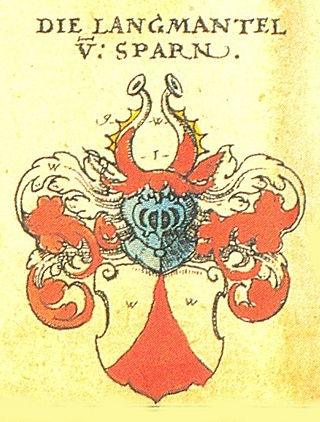
Christoph Langenmantel or Christoph Langenmantel vom Sparren was a nobleman, Carmelite friar, canon of Freising and a supporter of Martin Luther.
"Nun singt ein neues Lied dem Herren" is a Christian hymn with German text by Georg Thurmair. He based it on Psalm 98 and wrote it in 1967 to match a traditional 16th-century melody. The song is part of German hymnals, including Gotteslob, and songbooks.